My Process
Each painting is a very personal creation for me, and there’s a story behind every single one of them. When I look back at a painting, I can remember exactly where I was when the inspiration hit me, how it was created and what life was like when I was working on it. While each painting tends to take on a life of its own in my studio, I do have a similar approach to the creative process. Here’s a brief look at each step in the process.
By the Numbers
On average, a 24” x 30” Original Oil Painting results in:
- 5 Concept Sketches
- 9 Ounces of Paint
- 11 Different Brushes
- 46 Hours of Studio Painting
- 340 Hours to Dry
- 720 Square Inches of Canvas
- Two hands
- One of a Kind
Step 1: Know your Subject.
I don’t paint any subject that I don’t know well. My general rule of thumb is that I have to hunt them before I paint them. There’s so many nuances to an animal’s anatomy, habitat and behavior that it helps to study and observe them in the field. I also paint with the hunter in mind, which means I’m painting deer and waterfowl in the fall, turkeys in the spring, etc – scenes that the hunter can relate to. The only way I can accurately pull this off is to immerse myself in that environment and be fully present, then let these experiences inspire new work.
Step 2: Inspiration.
In all the years I’ve painted, I’ve never been able to force inspiration. Like experienced hunters will tell you, “It’ll happen when you least expect it.” That may be a whitetail suddenly appearing at a scrape on the edge of a cornfield, or a bull elk screaming on a ridgetop, the mist of his breath lit up by the sunrise. The best way to capture it is simply to be ready when it hits you. I prefer to carry my DSLR camera and sketch pad with me if possible, but these days an iPhone can capture enough detail for me to work from in the studio. Often I’ll work with freelance wildlife photographers or stock photo sites to obtain reference for the wildlife when I need them.
Step 3: Materials
I work almost exclusively in two mediums: oil paint and charcoal pencil. My larger paintings are done on canvas and smaller paintings are often done on board. I like the sturdy, solid surface of a board, but most times a stretched canvas is a better solution for larger pieces. When I sketch, I typically use a Bic mechanical pencil (it ain't fancy, but I like the soft lead and I don’t have to slow down to sharpen it like a traditional pencil) and work on a small 8”x10” sketchpad.
Step 4: Prep Work
I prefer to sketch at night after the kids go to bed or in an area outside my studio. I find the fresh perspective helpful. I can also get impatient when I have an idea, and physically being away from the canvas helps me to curb the impulse to simply get right to painting. Most of my sketches are around 3”x5” – large enough for some detail but not so large that I’m compelled to draw every hair on a hide. I like to work quickly when I sketch, using these drawings to work out the composition and anatomy of the animal.
Step 5: Composition
Once I’ve done several sketches and have an idea of what I want to produce, I’ll create a digital image to work from. Often this is a compilation of several sources including photography, sketches and elements from memory. It’s not uncommon for me to use 4-5 photos of an animal and combine bits and pieces from each – the stance from one photo, head and neck from another, antlers from still another photo, then manually change the ears to what I think they should be. Then I’ll put the animal on a photo I took from a recent trip. Once this loose concept is put together digitally, I’ll take it to my easel for the creation of the finished piece.
Step 6: Painting begins.
This phase lasts anywhere from 8 to 80 hours per piece. For smaller pieces, I’ll get right to painting and the first marks on canvas will be brushstrokes. For larger paintings, I’ll sketch the composition on canvas to work out the proportions before I actually apply paint. Then I’ll put down a thin layer of paint to get some color on the canvas and block in shapes. After that comes full color application. Once complete, I’ll let the piece sit for a day or two then come back to it with fresh eyes, often seeing things I want to change or adjust.
Step 7: Drying
Oil paint takes a while to dry. If it’s thinned with medium, sometimes it’s dry to the touch overnight. If it’s applied thick with a palette knife, it can take weeks to dry fully. Once dry, I apply a satin varnish to protect the piece and bring back the luster of the original paint, just like the day I first applied it.
Step 8: Final Touches
From paper prints to original oil paintings on canvas, I carefully inspect and sign each piece. Originals are signed with oil paint before varnishing, then framed and hung in my gallery until they’re sold. I try to deliver each original when possible, but often they’re shipped to buyers all over the country. We’ve shipped originals from Oregon, to Texas, to Vermont and just about everywhere in between. Before shipping, I take a high-resolution photo for my portfolio, which are the images you’ll see on this site.
Now that you know my process behind the paintings, I encourage you to take a look at each piece, keeping in mind the careful attention to composition, anatomy, color and craft that go into them. From concept to creation, each piece is truly #WildyOriginal.

